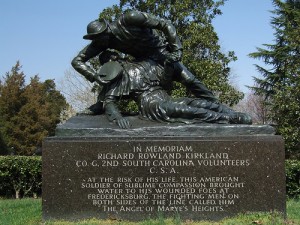 I love those little bursts of creativity that I occasionally have in the classroom. With my commemoration talk scheduled for Sunday in Fredericksburg and my Civil War Memory classes focused on the analysis of soldier monuments, their inscriptions, as well as dedication talks, I decided to place them in the position of speaker and come up with their own presentation. Actually, they had to focus on the individual themes that they would include in the speech rather than write it out. Without telling them that I am the one scheduled to give the talk I described the setting beginning with a brief description of the battle, the Kirkland Memorial, and cemetery as well as the schedule for the ceremony. I referenced the wreath-laying, which will be carried out by the Sons of Confederate Veterans, Sons of Union Veterans, and Daughters of the Confederacy and described the purpose of the ceremony itself.
I love those little bursts of creativity that I occasionally have in the classroom. With my commemoration talk scheduled for Sunday in Fredericksburg and my Civil War Memory classes focused on the analysis of soldier monuments, their inscriptions, as well as dedication talks, I decided to place them in the position of speaker and come up with their own presentation. Actually, they had to focus on the individual themes that they would include in the speech rather than write it out. Without telling them that I am the one scheduled to give the talk I described the setting beginning with a brief description of the battle, the Kirkland Memorial, and cemetery as well as the schedule for the ceremony. I referenced the wreath-laying, which will be carried out by the Sons of Confederate Veterans, Sons of Union Veterans, and Daughters of the Confederacy and described the purpose of the ceremony itself.
The goal was a class discussion and it turned out to be one of the more engaging of the semester thus far. In both sections students suggested beginning with the Kirkland Memorial as a way of emphasizing the theme of brotherhood, reunion, and bravery. We talked a bit about the importance of honoring the fallen and why we find a need to do so.
What I found interesting, however, was the level of disagreement surrounding the referencing of themes that go beyond the battlefield. For instance, in both sections it didn’t take long for a student to suggest the importance of emancipation and the end of slavery as important factors for a commemoration talk. Students took very strong positions on this distinction. For those who agreed it was a matter of acknowledging what the war accomplished while those who disagreed saw little but division. From one perspective it came down to a disagreement over the proper time frame for the talk: Should it cover 1861-1865 and stick to the battlefield specifically or should it reach beyond not only the battlefield, but the war years itself? At least one student in each class suggested referencing the recent election of our nation’s first black president, while others thought that this would also prove to be problematic. It turned out to be problematic on two levels; on the one hand it threatens the bonds of affection and heroic traits found in the broader theme of reunion as well as the setting [Kirkland Memorial] for the ceremony.
The discussion moved to the question of who the commemoration is for. Is it for the Civil War generation, the living, or both? There seemed to be little agreement on this question. A number of students kept coming back to the distinction between Lincoln’s Gettysburg Address and Woodrow Wilson’s 1913 speech on the 50th anniversary of the battle. They were drawn to the way Lincoln connected the meaning of the battle to the founding ideals in Declaration of Independence as well as the way he reminded his audience and future generations of their obligations to ensure that “these men shall not have died in vain.” Others appreciated Wilson’s focus on the veterans in attendance in 1913 and understood the overall theme of “the quarrel forgotten” even though they acknowledged the racial backdrop of Jim Crow.
A few of the students kept pressing me to share my own ideas. It was not until the end of the course when I decided to reveal that I am the one giving the commemoration talk. I promised to allow them the opportunity to critique it on Monday.
Unfortunately, I did not have the time to turn this little exercise into a formal lesson plan. I do think, however, that this can be done in any history class. It forces students to think about what is worth remembering/commemorating and why. Next time, I will definitely ask students to write a formal address as well as deliver it to the rest of the class. One of the things that a classroom address would allow for are images that the student could use to provide a visual setting for the subject of the presentation. In February I will be working with a group of high school teachers on how to teach the Civil War and memory through a TAH Grant. My goal is to introduce a lesson plan based on writing commemorative speeches for this session.